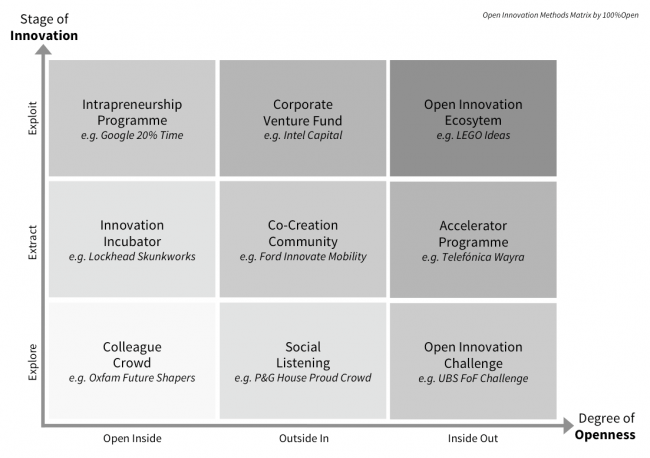The Open Innovation Methods Matrix – Part 1.
When it comes to open innovation, knowing where to start or what to do next can often be the hardest decision. This uncertainty leads to inaction and missed opportunities. To counter this, we have produced a simple tool (below), which is based on our range of practical experience, to show the most common and relevant methods to successfully innovate openly.

There are varying degrees of openness that are relevant and helpful depending on your sector and circumstances (the X-axis), which include:
- Open Inside – Breaking down internal silos and connecting and empowering employees to contribute to innovation.
- Outside In – Sourcing external ideas, talent and technology to solve known challenges or enhance existing capability.
- Inside Out – Sharing internal ideas, talent and technology to tackle as yet unknown opportunities and create new capabilities.
Additionally, the value of opening up is very different depending on which stage of the innovation process you are at (the Y-axis). The three stages are:
- Explore – To listen to and engage with others to find new insights and to use these insights to identify and address new and unmet needs.
- Extract – To collaborate with others to build on those unmet needs, to develop new ideas and to test and prototype potential solutions.
- Exploit – Incorporating lessons learned from the prototype solutions, to develop and implement robust business plans and investable propositions together.
In the next post, we’ll describe a range of open innovation methods together with examples, and explain how they apply to The Open Innovation Methods Matrix.
Is very good work.
Thank you Galo. Glad you liked it. Roland
Great post and feels a very practical guide to getting to new or more efficient ways and outcomes. Cheers Roland
Thanks so much Jiveen. I hope all is going well back in NZ. All the best, Roland
Very often companies overlook their employees’ individual talents and strength missing out on valuable existing free resources that are untapped du to the rigid bureaucratic system in place.
Hi Coco. I couldn’t agree with you more. Lots of evidence (e.g. Gartner) suggests that in most FTSE companies only around 20% of employees are engaged which leads to huge untapped potential and resources. And this is one of the reasons why 3 of the boxes on the left hand side of the matrix are all about accessing employee talent, ideas and capabilities. All the best, Roland